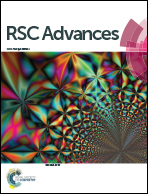Vertical liquid crystal orientation of phytochemical-based oryzanol modified polystyrene
Abstract
Using plant-derived oryzanol, we synthesized a series of phytochemical-based oryzanol-modified polystyrenes (PORZ#, # = 20, 40, 60, 80, or 100, where # is the mole fraction of the oryzanol moiety) using polymer modification reactions in order to investigate their liquid crystal (LC) orientation behaviors. Generally, an LC cell made from polymer films with a higher mole fraction of the oryzanol side group showed vertical LC orientation behavior. The vertical orientation behavior was strongly correlated with the surface energy of these polymer films. For instance, the vertical orientation was observed when the polymer's surface energy, which is influenced by the nonpolar and long carbon groups, was less than about 40.42 mJ m−2. Good electro-optical properties, such as the aligning stabilities at 250 °C and ultraviolet (UV) irradiation of 20 J cm−2, the voltage holding ratio, and the residual DC voltage (R-DC), were observed for the LC cells fabricated using PORZ100 as an eco-friendly LC orientation layer.



 Please wait while we load your content...
Please wait while we load your content...